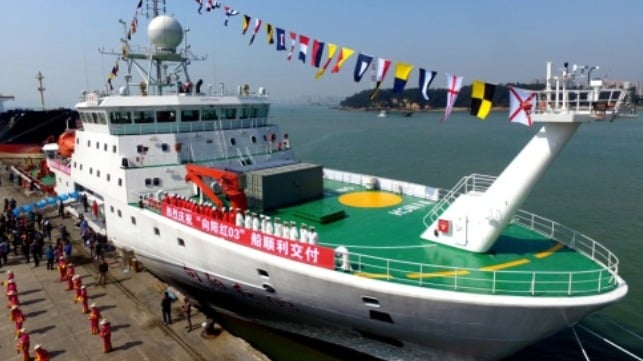Indonesia Intercepts Chinese Research Vessel Running "Dark"

Last week, Indonesia's Maritime Security Agency (Baklama) intercepted a Chinese research vessel running without AIS in the strategic Sunda Strait. The incident follows shortly after the discovery of a suspected Chinese survey drone in the nearby Makassar Strait.
“[Patrol vessel] KN Pulau Nipah 321 intercepted Chinese research vessel Xiang Yang Hong 03 on Wednesday evening at about 8 p.m. while it was passing through the Sunda Strait,” said Bakamla spokesman Col. Wisnu Pramandita. According to Col. Pramandita, the vessel's AIS was not broadcasting during three intervals as she transited through Indonesian waters. No boarding was conducted, but in a radio exchange, the crew of the Xiang Yang Hong claimed that their AIS was malfunctioning.
No boarding was undertaken due to unfavorable weather, and the patrol vessel escorted the Xiang Yang Hong out of the Indonesian EEZ.
AIS data shows that the Xiang Yang Hong left China's Hainan Island on January 6. Her AIS was received only intermittently as she headed southwards through the South China Sea and Java Sea, according to tracking provided by Pole Star.
As of January 18, the Xiang Yang Hong was under way again in the Indian Ocean, broadcasting restricted maneuverability and moving ahead at a slow bell.
The run-in occurs as the Indonesian Navy investigates the origins of an unmarked autonomous underwater vehicle (AUV) found at Selayar Island, South Sulawesi in late December. Selayar is located near the southern entrance of the strategic Makassar Strait, one of the alternatives to the Strait of Malacca.
The drone - a seven foot aluminum tube with a three-foot trailing antenna - was discovered by a fisherman on the morning of December 26. He reported it to local officials, who transferred it to the Indonesian Navy's hydrography and oceanography division in Jakarta.
Analysts suggest that the device bears a strong resemblance to the Chinese Academy of Science's Sea Wing (Haiyi) research glider. It is believed to be the third unit of its kind found in Indonesian waters, though the first widely publicized.
